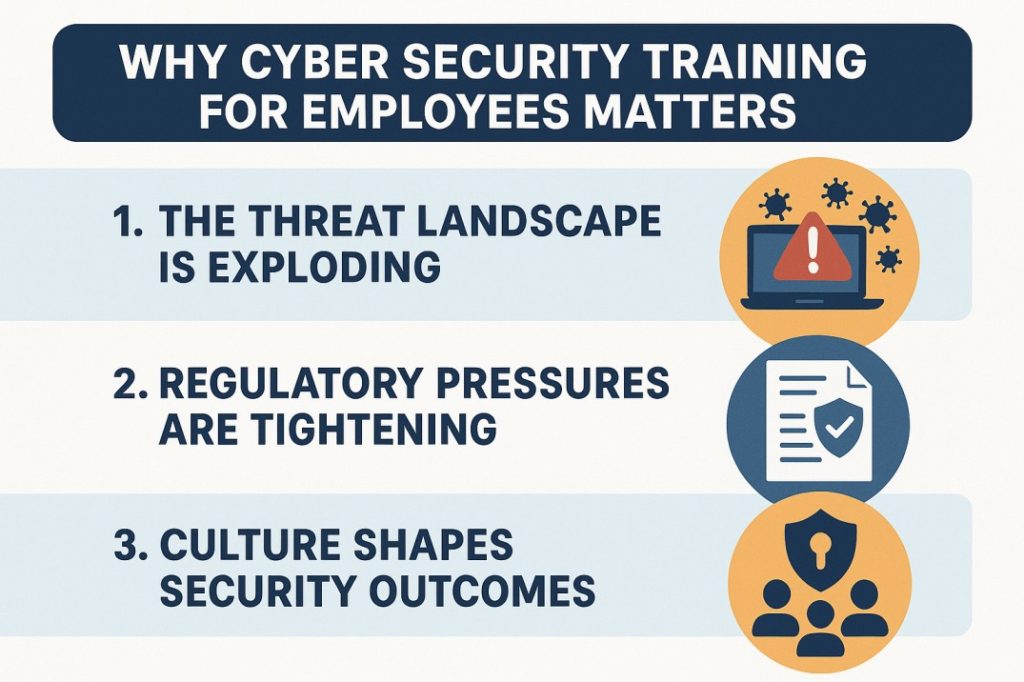Every click, share, or download inside your organisation can open a door for attackers—or shut them out. This comprehensive guide explores cyber security training for employees, showing you how to build, deliver, and measure a program that turns every staff member into a vigilant human firewall. Whether you’re rolling out cyber security awareness training for employees for the first time or upgrading to sophisticated cyber security training online platforms, you’ll find practical frameworks, vendor-selection checklists, and a 90-day roadmap to success.
Why Cyber Security Training for Employees Matters
1. The Threat Landscape Is Exploding
Phishing kits are now sold for less than the price of lunch, ransomware groups operate like Fortune-500 enterprises, and AI-generated deepfakes blur fact and fiction. In this climate, a well-crafted spear-phish directed at an untrained receptionist can cascade into multi-million-dollar losses. Statistics show that over 80 % of breaches still hinge on human error—reinforcing the need for systematic, ongoing cyber security awareness training for employees.
2. Regulatory Pressures Are Tightening
GDPR, HIPAA, PCI-DSS, and dozens of emerging data-protection acts require demonstrable employee training. Non-compliance risks fines that dwarf the cost of prevention. A documented program—and an audit trail proving employees completed relevant cyber security training courses for employees—is no longer optional.
3. Culture Shapes Security Outcomes
Technology alone can’t stop staff from re-using passwords or sharing access cards. Creating a security-first culture through compelling, role-based education elevates everyday decisions: the developer who sanitises input by default, or the HR exec who spots a fraudulent request before payroll data leaks.
Architecting an Employee-Centric Cyber Security Awareness Program
Step 1: Assess Current Maturity
Run phishing simulations, policy reviews, and employee surveys to pinpoint gaps. Map findings to a framework like NIST CSF or ISO 27001 so you know which knowledge areas to prioritise: email hygiene, social-engineering red flags, secure coding, or data-classification protocols.
Step 2: Define Measurable Learning Objectives
- Reduce click-rate on simulated phishing emails to <5 % within six months.
- Achieve 100 % completion of core cyber security training courses for employees by quarter-end.
- Increase incident-report submissions by 30 %, proving heightened vigilance.
Step 3: Map Content to Job Roles
One size rarely fits all. Finance teams need extra depth on payment-card fraud; developers must master OWASP Top 10; executives should focus on reputational risk and board-level accountability. Personalizing your cyber security training online boosts relevance and retention.
Step 4: Blend Learning Modalities
Combine micro-videos, interactive simulations, and live drills. “Break-room” posters and desktop widgets keep key tips visible. Real-world phishing drills turn theory into instinctive behaviour. Together, these elements create a neuro-anchor that triggers safe choices in the moment of risk.
Cyber Awareness Training
Stay safe in the digital world. Learn how to identify threats, protect sensitive data, and follow best practices to defend against cyber attacks.
Selecting the Best Cyber Security Training Courses for Employees
In-Person vs. Cyber Security Training Online
Instructor-led workshops foster dialogue and can kick-start culture change, yet scale poorly across global teams. Modern cyber security training online platforms deliver the same expert content asynchronously, tracking each click for compliance reports. A hybrid model—live kick-off followed by digital reinforcement—often yields the highest ROI.
Must-Have Features Checklist
- Adaptive paths: modules adjust to each learner’s baseline knowledge.
- Attack simulations: phishing, smishing, and USB-drop scenarios.
- Multi-language support: critical for global rollouts.
- LMS integrations: SCORM/xAPI export or direct API.
- Granular analytics: heat-maps, behavioural metrics, audit-ready transcripts.
Evaluating Vendors
Look beyond glossy demos. Ask for evidence of behaviour change, not just quiz scores. Review sample reporting dashboards, verify GDPR/Data-Residency compliance (if EU/UK), and demand SLAs for platform uptime and support response.
Discover how our courses can align with your training goals and drive real results.
Learning Built Around Your Goals.
Schedule A DemoDelivering Cyber Security Training Online: Best Practices
Mobile-First Microlearning
Employees already check phones dozens of times per hour. Bite-sized lessons (≈5 minutes) that run flawlessly on mobile turn idle moments into learning opportunities. Design for thumbs, not cursors: large tap targets and vertical video.
Storytelling & Gamification
Humans remember stories, not statistics. Build narratives around relatable characters—an accountant almost wiring money to a spoofed CEO—then let learners “choose the ending.” Points, badges, and leaderboards tap into intrinsic motivation without feeling childish.
Reinforcement Through Real-Time Simulations
Monthly phishing sims keep awareness fresh. When an employee clicks, direct them to a “just-in-time” micro-module explaining the red flags they missed. This contextual feedback cements learning far better than annual slide decks.
Measuring Impact
- Behavioural metrics: phishing click-rate trend, password reset frequency.
- Business metrics: incident volume, mean-time-to-detect (MTTD).
- Compliance metrics: completion %, audit-pass rates.
Sustaining a Culture of Continuous Cyber Security Awareness
Security Champions Network
Recruit enthusiasts in each department to localise messages and act as first-line mentors. Quarterly meet-ups give them fresh material and recognise their contribution—multiplying security’s reach without ballooning headcount.
Embed Training Into Daily Workflow
Integrate bite-sized tips into Slack or Microsoft Teams, surface policy reminders when users access sensitive files, and automate nudges via the HRIS on work anniversaries. Continuous micro-interactions beat annual “drinking-from-the-fire-hose” days.
Implementation Roadmap: 90-Day Action Plan
Phase 1 | Weeks 1–3 — Assessment & Alignment
- Conduct baseline phishing simulation & culture survey.
- Map gaps to compliance mandates (ISO 27001, CCPA, etc.).
- Secure executive sponsorship and budget.
Phase 2 | Weeks 4–8 — Core Program Roll-out
- Deliver mandatory cyber security training for employees modules via LMS.
- Launch KPI dashboard accessible to managers.
- Initiate monthly phishing simulations.
Phase 3 | Weeks 9–13 — Reinforcement & Optimisation
- Introduce advanced role-based paths (e.g., developers, executives).
- Analyse data; refine content for weak spots.
- Celebrate milestone; share success metrics company-wide.
How CogniSpark AI Enhances Cyber Security Awareness Programs
Building a human firewall requires more than just static training slides—it demands dynamic, AI-powered experiences that adapt to your workforce’s evolving knowledge and risk profile. CogniSpark AI brings intelligence, interactivity, and scalability to your cyber security training strategy. With SCORM-compliant modules, built-in authoring tool, and LMS-ready compatibility, the platform lets you create personalized, job-role-specific content effortlessly.
Its AI tutor guides learners in real time, enhancing retention through contextual feedback, micro-quizzes, and interactive simulations. Whether you’re running phishing simulations, deploying multilingual content, or integrating real-time analytics to measure behavioural change, CogniSpark ensures that your cyber security training is not just compliant but genuinely impactful.
Scale cybersecurity training quickly with Paradiso Solutions’ course catalog, offering 100+ ready-made courses across cybersecurity, data privacy, and threat awareness to support comprehensive workforce development alongside your customized training initiatives.
Conclusion & Next Steps
A resilient security posture rests on people as much as firewalls and encryption. By following this guide—grounded in proven frameworks and real-world success—you’ll transform staff into proactive defenders. Start today: audit your gaps, choose engaging cyber security awareness training for employees, and set measurable goals. In a threat landscape where milliseconds count, educated humans remain your most adaptive, scalable defence. Ready to raise the bar? Put your 90-day plan in motion and watch the risk curve bend in your favour.
Explore Our eLearning Course Catalog
Access 100+ fully editable, SCORM-compatible courses featuring an integrated AI Tutor and an in-built authoring tool. Seamlessly compatible with any LMS, these courses are designed to elevate your training programs.
Explore Course CatalogFrequently Asked Questions
How often should employees complete cyber security training?
Core awareness modules should recur annually, with quarterly refreshers and continuous micro-content for high-risk roles. Phishing simulations every 4–6 weeks keep skills sharp.
What is the ideal length of an online module?
Studies show completion rates peak at 3-to-7-minute segments. Microlearning chunks respect attention spans while allowing dense topics to be explored over multiple installments.
Does cyber security training for employees really reduce incidents?
Yes. Organisations with mature programs report up to 60 % reduction in phishing click-rates and materially lower breach costs (IBM Cost of a Breach 2024).
How do we prove compliance to auditors?
Modern platforms provide completion certificates, quiz scores, and simulation results exportable as CSV or tied directly into GRC systems via API—creating an immutable audit trail.
Smart & Editable Course Catalog
Stop struggling with rigid course listings. Paradiso’s Course Catalog is fully customizable, works with any LMS, and gives you the power to update and manage courses with ease.

























